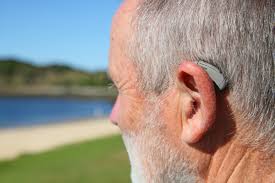
A small study suggests hearing aids help older people with hearing loss better maintain their balance.
In The Laryngoscope journal, researchers from the Washington University School of Medicine in St. Louis, MO, describe how they found older patients with hearing lossappeared better able to balance when their poor hearing was enhanced with hearing aids.
For the study, the researchers enrolled 14 people age 65-91 and used standard balance tests to measure the participants’ postural balance when their hearing aids in both ears were switched on and also when the aids were switched off.
Senior author Timothy E. Hullar, professor of otolaryngology at the School of Medicine, says they do not think the improvement in balance was just due to hearing aids helping the patients be more alert.
“The participants appeared to be using the sound information coming through their hearing aids as auditory reference points or landmarks to help maintain balance, ” he explains.
Prof. Hullar compares it to when we use our eyes to tell us where we are in space. If we turn the lights off, we tend to sway a bit – more than we do when we can see.
“This study suggests that opening your ears also gives you information about balance,” he notes.
First study to show sound directly helps maintain postural stability
The study, although small, is apparently the first to show that sound itself – as opposed to the balance system of the inner ear – helps us maintain postural stability. As the participants underwent their balance tests with and without their hearing aids switched on, the researchers played white noise in the background – this generates sound rather like radio static.
One of the tests involved the participants having their eyes covered, standing with their feet together on a thick foam pad. In another more challenging test, the participants had to stand on the floor with one foot in front of the other heel-to-toe, again with their eyes covered.
The researchers measured how long the participants could stand in these positions without needing to move their arms or feet, or help with their balance.
More improvement seen in those who found it harder to maintain stability
Some of the participants could stand steady on the pad for 30 seconds or more – which is considered normal – whether their hearing aids were turned on or not.
But the participants who had difficulty maintaining stability this long performed better when they had their hearing aids turned on. Also, the improvement in balance was greater in the more challenging test.
In the foam pad test, the average duration of stability was 17 seconds with the hearing aids off and nearly 26 seconds with them on.
In the more challenging heel-to-toe test, the participants, on average, were able to stand steady for 5 seconds with their hearing aids off and 10 seconds with them turned on.
The authors note that these differences are statistically significant, even though there were not many subjects in the trial.
They acknowledge that one limitation of the study is that the participants could tell when their hearing aids were on and off – and this could have influenced the results.
However, they did try to offset this by introducing an element of randomization – the participants sometimes performed the tests with the hearing aids off first and then on again second, and sometimes it was the other way around. There was no fixed pattern.
“This is a small study,” Prof. Hullar notes, “Obviously it needs to be repeated in a much larger study, and we’re seeking funding to do that.”
In July 2014, Medical News Today learned how engineers are working on a new type of hearing aid that emulates a fly’s ability to pinpoint sound and can be housed in a tiny device that does not require a bulky battery.
Written by Catharine Paddock PhD
Copyright: Medical News Today
Not to be reproduced without permission.
The effect of hearing aids on postural stability, Kavelin Rumalla et al., The Laryngoscope, doi:10.1002/lary.24974, published online 24 October 2014, abstract.
Washington University in St. Louis news release accessed 18 December 2014.
Visit our Hearing / Deafness category page for the latest news on this subject.
Please use one of the following formats to cite this article in your essay, paper or report:
MLA
Paddock, Catharine. “Balance in older adults may improve with hearing aids.” Medical News Today. MediLexicon, Intl., 18 Dec. 2014. Web.
18 Jan. 2015. <https://www.medicalnewstoday.com/articles/287180.php>
APA
Paddock, C. (2014, December 18). “Balance in older adults may improve with hearing aids.” Medical News Today. Retrieved from
https://www.medicalnewstoday.com/articles/287180.php.
Please note: If no author information is provided, the source is cited instead.
The effect of hearing aids on postural stability, Kavelin Rumalla et al., The Laryngoscope, doi:10.1002/lary.24974, published online 24 October 2014, abstract.
Washington University in St. Louis news release accessed 18 December 2014.
Visit our Hearing / Deafness category page for the latest news on this subject.



